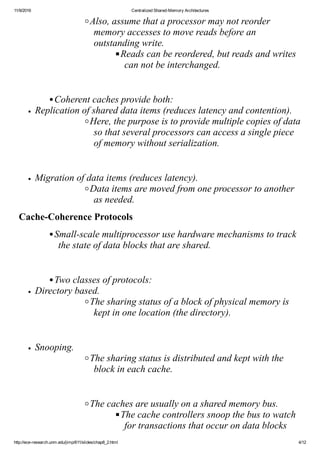Centralized shared memory architectures
- 5. 11/9/2016 Centralized SharedMemory Architectures http://eceresearch.unm.edu/jimp/611/slides/chap8_2.html 5/12 that they hold. Bus Snooping Protocols Write invalidate. It is the most common protocol, both for snooping and for directory schemes. The basic idea behind this protocol is that writes to a location invalidate other caches' copies of the block. Reads by other processors on invalidated data cause cache misses. If two processors write at the same time, one wins and obtains exclusive access. Processor activity Bus activity Contents of CPU A's cache Contents of CPU B's cache Contents of mem location X CPU A reads X Cache miss 0 0 CPU B reads X Cache miss 0 0 0 CPU A writes 1 Invalidate 1 0 CPU B reads X Cache miss 1 1 1 This example assumes a writeback cache. Bus Snooping Protocols Write broadcast (write update). An alternative is to update all cached copies of the data item when it is written.
- 6. 11/9/2016 Centralized SharedMemory Architectures http://eceresearch.unm.edu/jimp/611/slides/chap8_2.html 6/12 To reduce bandwidth requirements, this protocol keeps track of whether or not a word in the cache is shared. If not, no broadcast is necessary. Processor activity Bus activity Contents of CPU A's cache Contents of CPU B's cache Contents of mem location X CPU A reads X Cache miss 0 0 CPU B reads X Cache miss 0 0 0 CPU A writes 1 Broadcast 1 1 1 CPU B reads X 1 1 1 This example also assumes a writeback cache. Performance Differences between Bus Snooping Protocols Write invalidate is much more popular. This is due primarily to the performance differences. Multiple writes to the same word with no intervening reads require multiple broadcasts. With multiword cache blocks, each word written requires a broadcast. For write invalidate, the first word written invalidates. Also write invalidate works on blocks , while write broadcast must work on individual words or bytes. The delay between writing by one processor and reading by another is lower in the write broadcast scheme. For write invalidate, the read causes a miss.
- 10. 11/9/2016 Centralized SharedMemory Architectures http://eceresearch.unm.edu/jimp/611/slides/chap8_2.html 10/12 Write hit Processor Write data in cache. Read miss Bus Request data from cache or memory. Write miss Bus Request data from cache or memory (perform any needed invalidates). This causes processors with copies to invalidate them. An Example Centralized SharedMemory Snooping Protocol Write invalidation and a writeback cache assumed: An Example Centralized SharedMemory Snooping Protocol These state transitions have no analog in a uniprocessor cache controller.












